Market Strategy Report 2019: Inclusion of Direct Strategies at LNU
VerifiedAdded on 2022/09/05
|24
|7083
|32
Report
AI Summary
This market strategy report, submitted by a student, investigates the integration of direct strategic applications within creative knowledge environments and their impact on learners at Linnaeus University (LNU). The research addresses the lack of specific strategies in LNU's vision and strategy document, focusing on learner behaviors and preferences to identify effective approaches. The report includes an introduction, theoretical framework, methodology, empirical investigation, and conclusion. It explores various strategies, including studying environments, gaming designs, curriculum construction, flipped classroom models, AI and 3D virtual worlds, technology-enhanced learning, nature engagements, emotional connections, teacher self-reflections, entrepreneur involvement, and design thinking. The study aims to determine which strategies are most effective based on learner perspectives and how they can positively influence the creative knowledge environment at LNU. The research also addresses the limitations of the study, such as the lack of directly applied data and in-depth studies on the topic. The report concludes with a discussion of the findings and recommendations for future research.
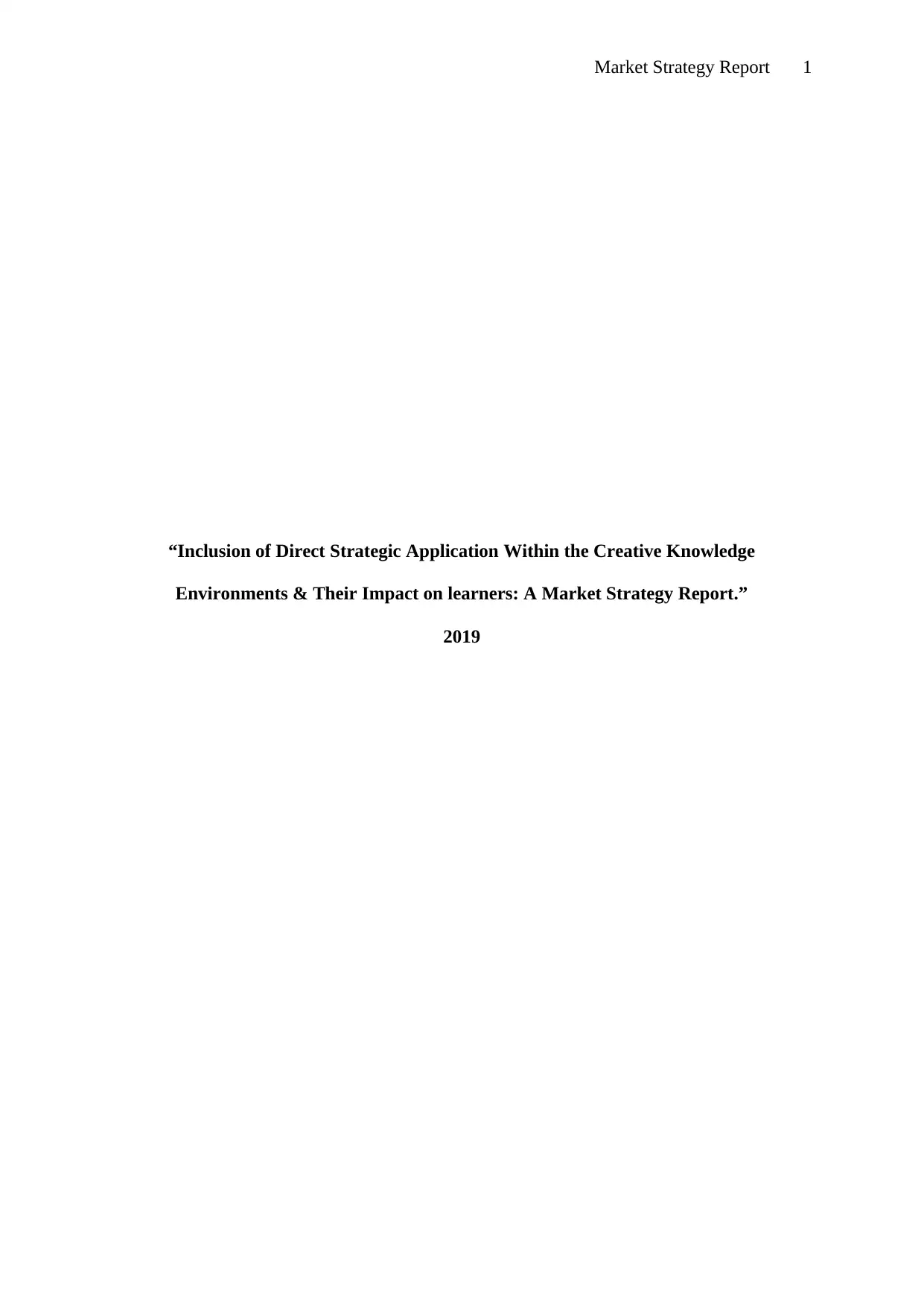
Market Strategy Report 1
“Inclusion of Direct Strategic Application Within the Creative Knowledge
Environments & Their Impact on learners: A Market Strategy Report.”
2019
“Inclusion of Direct Strategic Application Within the Creative Knowledge
Environments & Their Impact on learners: A Market Strategy Report.”
2019
Paraphrase This Document
Need a fresh take? Get an instant paraphrase of this document with our AI Paraphraser
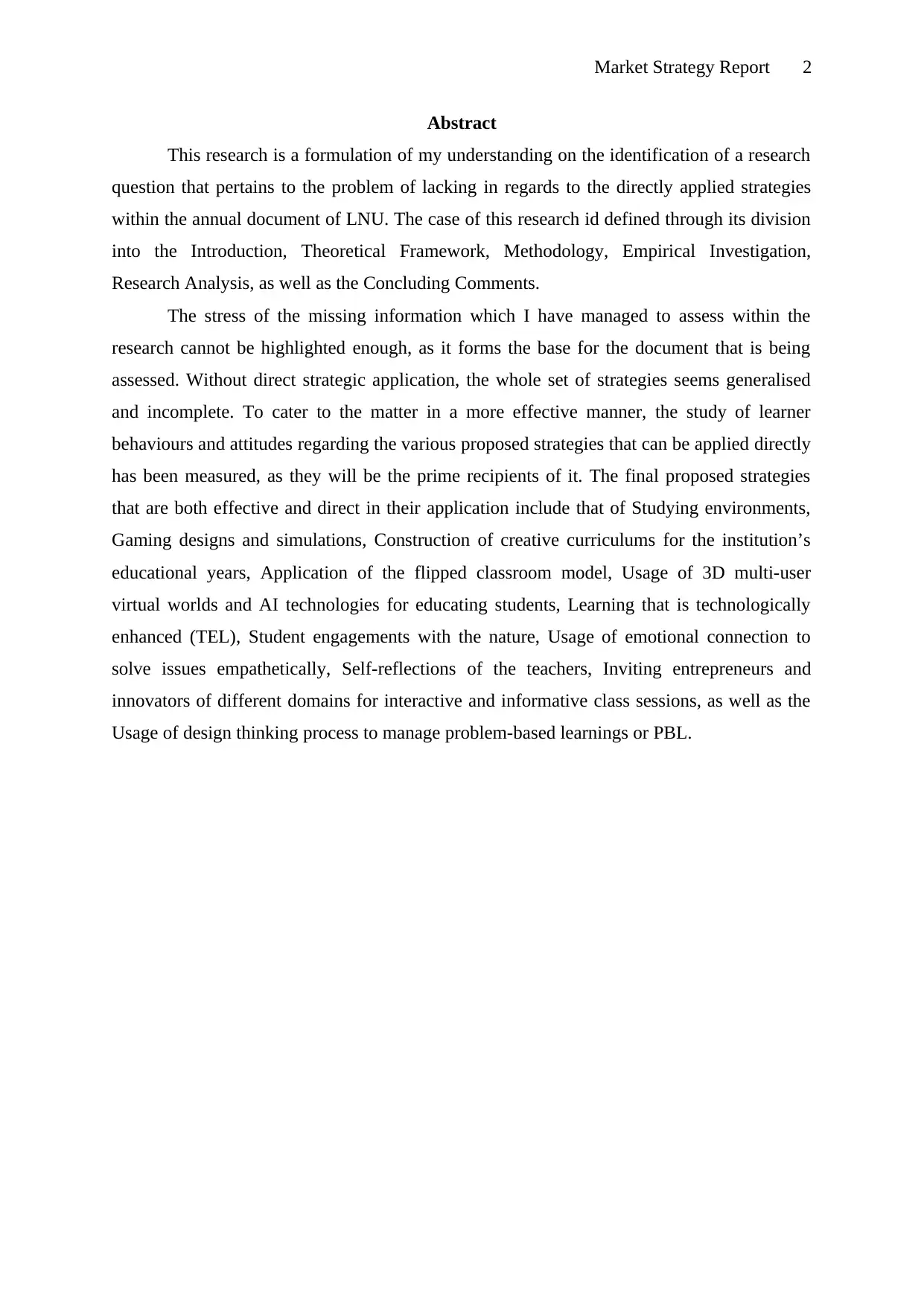
Market Strategy Report 2
Abstract
This research is a formulation of my understanding on the identification of a research
question that pertains to the problem of lacking in regards to the directly applied strategies
within the annual document of LNU. The case of this research id defined through its division
into the Introduction, Theoretical Framework, Methodology, Empirical Investigation,
Research Analysis, as well as the Concluding Comments.
The stress of the missing information which I have managed to assess within the
research cannot be highlighted enough, as it forms the base for the document that is being
assessed. Without direct strategic application, the whole set of strategies seems generalised
and incomplete. To cater to the matter in a more effective manner, the study of learner
behaviours and attitudes regarding the various proposed strategies that can be applied directly
has been measured, as they will be the prime recipients of it. The final proposed strategies
that are both effective and direct in their application include that of Studying environments,
Gaming designs and simulations, Construction of creative curriculums for the institution’s
educational years, Application of the flipped classroom model, Usage of 3D multi-user
virtual worlds and AI technologies for educating students, Learning that is technologically
enhanced (TEL), Student engagements with the nature, Usage of emotional connection to
solve issues empathetically, Self-reflections of the teachers, Inviting entrepreneurs and
innovators of different domains for interactive and informative class sessions, as well as the
Usage of design thinking process to manage problem-based learnings or PBL.
Abstract
This research is a formulation of my understanding on the identification of a research
question that pertains to the problem of lacking in regards to the directly applied strategies
within the annual document of LNU. The case of this research id defined through its division
into the Introduction, Theoretical Framework, Methodology, Empirical Investigation,
Research Analysis, as well as the Concluding Comments.
The stress of the missing information which I have managed to assess within the
research cannot be highlighted enough, as it forms the base for the document that is being
assessed. Without direct strategic application, the whole set of strategies seems generalised
and incomplete. To cater to the matter in a more effective manner, the study of learner
behaviours and attitudes regarding the various proposed strategies that can be applied directly
has been measured, as they will be the prime recipients of it. The final proposed strategies
that are both effective and direct in their application include that of Studying environments,
Gaming designs and simulations, Construction of creative curriculums for the institution’s
educational years, Application of the flipped classroom model, Usage of 3D multi-user
virtual worlds and AI technologies for educating students, Learning that is technologically
enhanced (TEL), Student engagements with the nature, Usage of emotional connection to
solve issues empathetically, Self-reflections of the teachers, Inviting entrepreneurs and
innovators of different domains for interactive and informative class sessions, as well as the
Usage of design thinking process to manage problem-based learnings or PBL.
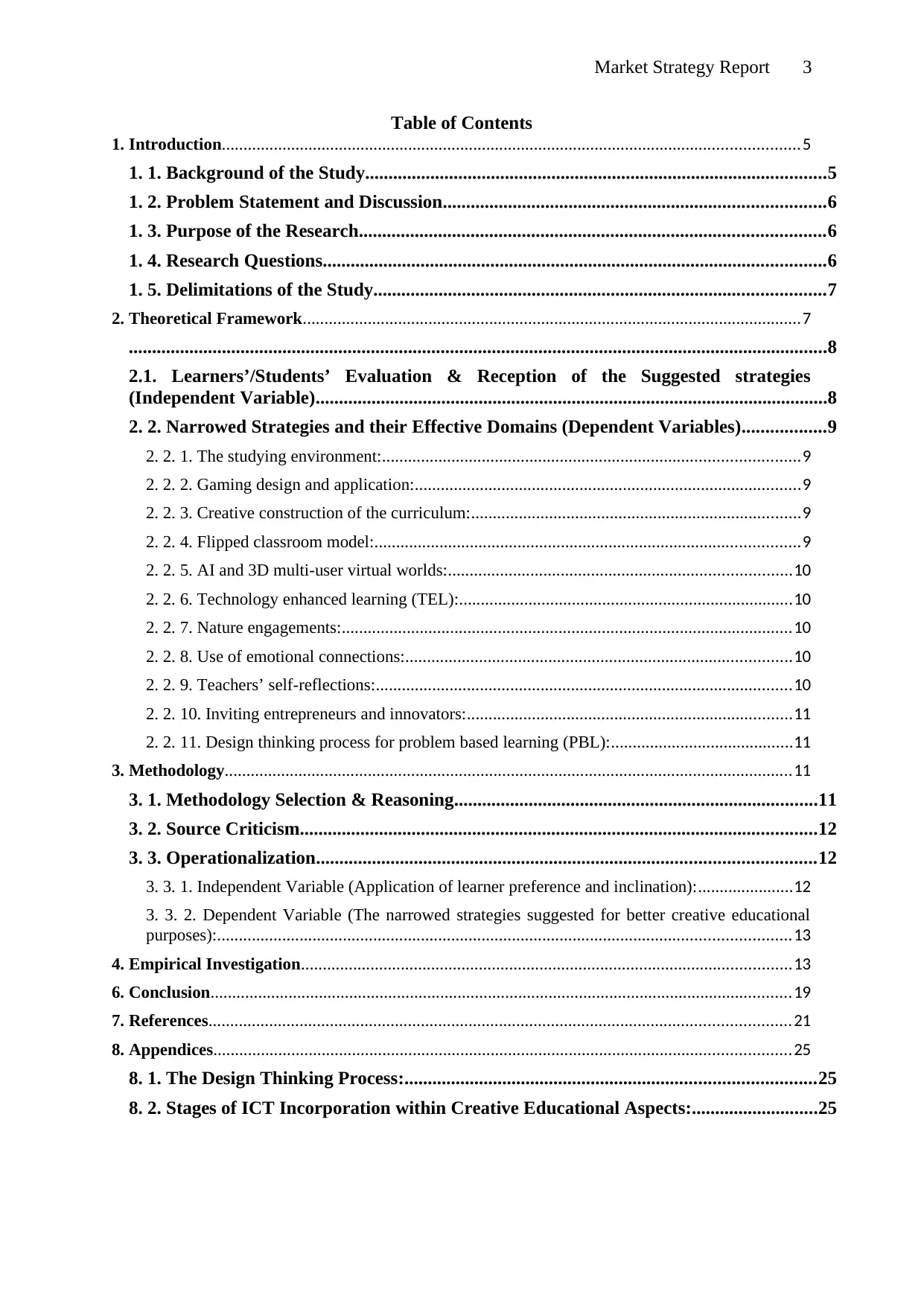
Market Strategy Report 3
Table of Contents
1. Introduction.....................................................................................................................................5
1. 1. Background of the Study...................................................................................................5
1. 2. Problem Statement and Discussion..................................................................................6
1. 3. Purpose of the Research....................................................................................................6
1. 4. Research Questions............................................................................................................6
1. 5. Delimitations of the Study.................................................................................................7
2. Theoretical Framework...................................................................................................................7
......................................................................................................................................................8
2.1. Learners’/Students’ Evaluation & Reception of the Suggested strategies
(Independent Variable)..............................................................................................................8
2. 2. Narrowed Strategies and their Effective Domains (Dependent Variables)..................9
2. 2. 1. The studying environment:................................................................................................9
2. 2. 2. Gaming design and application:.........................................................................................9
2. 2. 3. Creative construction of the curriculum:............................................................................9
2. 2. 4. Flipped classroom model:..................................................................................................9
2. 2. 5. AI and 3D multi-user virtual worlds:...............................................................................10
2. 2. 6. Technology enhanced learning (TEL):.............................................................................10
2. 2. 7. Nature engagements:........................................................................................................10
2. 2. 8. Use of emotional connections:.........................................................................................10
2. 2. 9. Teachers’ self-reflections:................................................................................................10
2. 2. 10. Inviting entrepreneurs and innovators:...........................................................................11
2. 2. 11. Design thinking process for problem based learning (PBL):..........................................11
3. Methodology...................................................................................................................................11
3. 1. Methodology Selection & Reasoning..............................................................................11
3. 2. Source Criticism...............................................................................................................12
3. 3. Operationalization...........................................................................................................12
3. 3. 1. Independent Variable (Application of learner preference and inclination):......................12
3. 3. 2. Dependent Variable (The narrowed strategies suggested for better creative educational
purposes):....................................................................................................................................13
4. Empirical Investigation.................................................................................................................13
6. Conclusion......................................................................................................................................19
7. References......................................................................................................................................21
8. Appendices.....................................................................................................................................25
8. 1. The Design Thinking Process:........................................................................................25
8. 2. Stages of ICT Incorporation within Creative Educational Aspects:...........................25
Table of Contents
1. Introduction.....................................................................................................................................5
1. 1. Background of the Study...................................................................................................5
1. 2. Problem Statement and Discussion..................................................................................6
1. 3. Purpose of the Research....................................................................................................6
1. 4. Research Questions............................................................................................................6
1. 5. Delimitations of the Study.................................................................................................7
2. Theoretical Framework...................................................................................................................7
......................................................................................................................................................8
2.1. Learners’/Students’ Evaluation & Reception of the Suggested strategies
(Independent Variable)..............................................................................................................8
2. 2. Narrowed Strategies and their Effective Domains (Dependent Variables)..................9
2. 2. 1. The studying environment:................................................................................................9
2. 2. 2. Gaming design and application:.........................................................................................9
2. 2. 3. Creative construction of the curriculum:............................................................................9
2. 2. 4. Flipped classroom model:..................................................................................................9
2. 2. 5. AI and 3D multi-user virtual worlds:...............................................................................10
2. 2. 6. Technology enhanced learning (TEL):.............................................................................10
2. 2. 7. Nature engagements:........................................................................................................10
2. 2. 8. Use of emotional connections:.........................................................................................10
2. 2. 9. Teachers’ self-reflections:................................................................................................10
2. 2. 10. Inviting entrepreneurs and innovators:...........................................................................11
2. 2. 11. Design thinking process for problem based learning (PBL):..........................................11
3. Methodology...................................................................................................................................11
3. 1. Methodology Selection & Reasoning..............................................................................11
3. 2. Source Criticism...............................................................................................................12
3. 3. Operationalization...........................................................................................................12
3. 3. 1. Independent Variable (Application of learner preference and inclination):......................12
3. 3. 2. Dependent Variable (The narrowed strategies suggested for better creative educational
purposes):....................................................................................................................................13
4. Empirical Investigation.................................................................................................................13
6. Conclusion......................................................................................................................................19
7. References......................................................................................................................................21
8. Appendices.....................................................................................................................................25
8. 1. The Design Thinking Process:........................................................................................25
8. 2. Stages of ICT Incorporation within Creative Educational Aspects:...........................25
⊘ This is a preview!⊘
Do you want full access?
Subscribe today to unlock all pages.

Trusted by 1+ million students worldwide
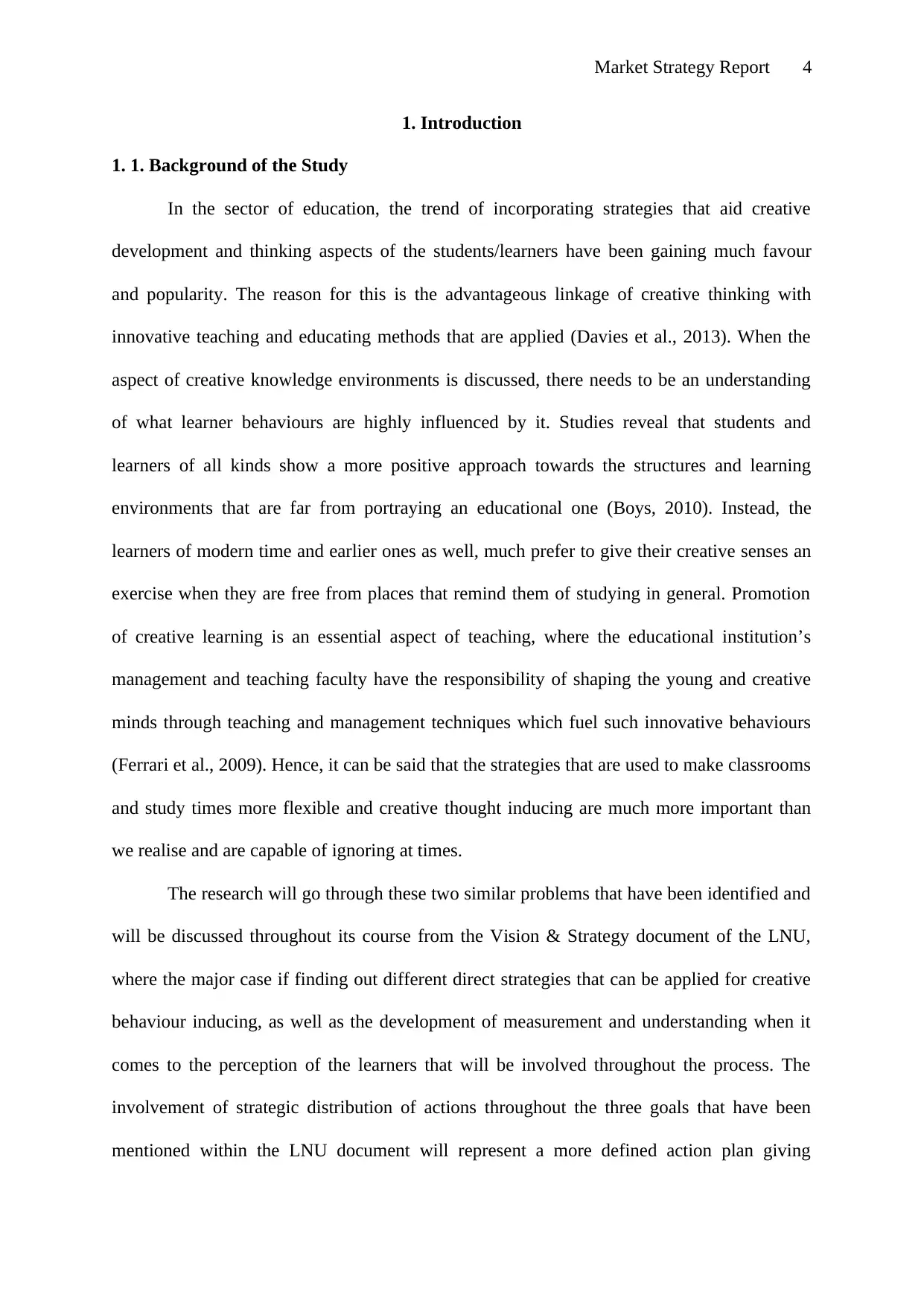
Market Strategy Report 4
1. Introduction
1. 1. Background of the Study
In the sector of education, the trend of incorporating strategies that aid creative
development and thinking aspects of the students/learners have been gaining much favour
and popularity. The reason for this is the advantageous linkage of creative thinking with
innovative teaching and educating methods that are applied (Davies et al., 2013). When the
aspect of creative knowledge environments is discussed, there needs to be an understanding
of what learner behaviours are highly influenced by it. Studies reveal that students and
learners of all kinds show a more positive approach towards the structures and learning
environments that are far from portraying an educational one (Boys, 2010). Instead, the
learners of modern time and earlier ones as well, much prefer to give their creative senses an
exercise when they are free from places that remind them of studying in general. Promotion
of creative learning is an essential aspect of teaching, where the educational institution’s
management and teaching faculty have the responsibility of shaping the young and creative
minds through teaching and management techniques which fuel such innovative behaviours
(Ferrari et al., 2009). Hence, it can be said that the strategies that are used to make classrooms
and study times more flexible and creative thought inducing are much more important than
we realise and are capable of ignoring at times.
The research will go through these two similar problems that have been identified and
will be discussed throughout its course from the Vision & Strategy document of the LNU,
where the major case if finding out different direct strategies that can be applied for creative
behaviour inducing, as well as the development of measurement and understanding when it
comes to the perception of the learners that will be involved throughout the process. The
involvement of strategic distribution of actions throughout the three goals that have been
mentioned within the LNU document will represent a more defined action plan giving
1. Introduction
1. 1. Background of the Study
In the sector of education, the trend of incorporating strategies that aid creative
development and thinking aspects of the students/learners have been gaining much favour
and popularity. The reason for this is the advantageous linkage of creative thinking with
innovative teaching and educating methods that are applied (Davies et al., 2013). When the
aspect of creative knowledge environments is discussed, there needs to be an understanding
of what learner behaviours are highly influenced by it. Studies reveal that students and
learners of all kinds show a more positive approach towards the structures and learning
environments that are far from portraying an educational one (Boys, 2010). Instead, the
learners of modern time and earlier ones as well, much prefer to give their creative senses an
exercise when they are free from places that remind them of studying in general. Promotion
of creative learning is an essential aspect of teaching, where the educational institution’s
management and teaching faculty have the responsibility of shaping the young and creative
minds through teaching and management techniques which fuel such innovative behaviours
(Ferrari et al., 2009). Hence, it can be said that the strategies that are used to make classrooms
and study times more flexible and creative thought inducing are much more important than
we realise and are capable of ignoring at times.
The research will go through these two similar problems that have been identified and
will be discussed throughout its course from the Vision & Strategy document of the LNU,
where the major case if finding out different direct strategies that can be applied for creative
behaviour inducing, as well as the development of measurement and understanding when it
comes to the perception of the learners that will be involved throughout the process. The
involvement of strategic distribution of actions throughout the three goals that have been
mentioned within the LNU document will represent a more defined action plan giving
Paraphrase This Document
Need a fresh take? Get an instant paraphrase of this document with our AI Paraphraser
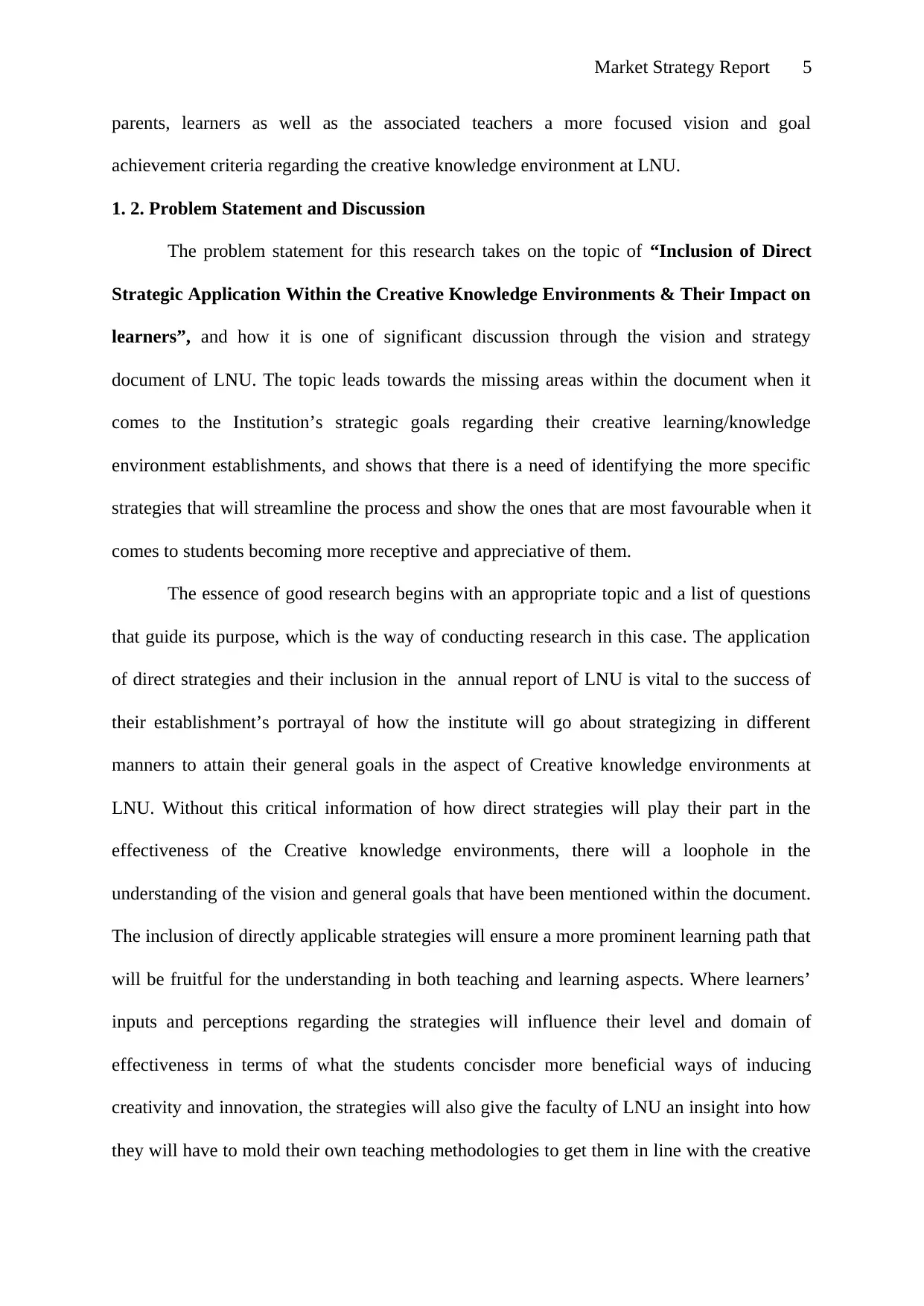
Market Strategy Report 5
parents, learners as well as the associated teachers a more focused vision and goal
achievement criteria regarding the creative knowledge environment at LNU.
1. 2. Problem Statement and Discussion
The problem statement for this research takes on the topic of “Inclusion of Direct
Strategic Application Within the Creative Knowledge Environments & Their Impact on
learners”, and how it is one of significant discussion through the vision and strategy
document of LNU. The topic leads towards the missing areas within the document when it
comes to the Institution’s strategic goals regarding their creative learning/knowledge
environment establishments, and shows that there is a need of identifying the more specific
strategies that will streamline the process and show the ones that are most favourable when it
comes to students becoming more receptive and appreciative of them.
The essence of good research begins with an appropriate topic and a list of questions
that guide its purpose, which is the way of conducting research in this case. The application
of direct strategies and their inclusion in the annual report of LNU is vital to the success of
their establishment’s portrayal of how the institute will go about strategizing in different
manners to attain their general goals in the aspect of Creative knowledge environments at
LNU. Without this critical information of how direct strategies will play their part in the
effectiveness of the Creative knowledge environments, there will a loophole in the
understanding of the vision and general goals that have been mentioned within the document.
The inclusion of directly applicable strategies will ensure a more prominent learning path that
will be fruitful for the understanding in both teaching and learning aspects. Where learners’
inputs and perceptions regarding the strategies will influence their level and domain of
effectiveness in terms of what the students concisder more beneficial ways of inducing
creativity and innovation, the strategies will also give the faculty of LNU an insight into how
they will have to mold their own teaching methodologies to get them in line with the creative
parents, learners as well as the associated teachers a more focused vision and goal
achievement criteria regarding the creative knowledge environment at LNU.
1. 2. Problem Statement and Discussion
The problem statement for this research takes on the topic of “Inclusion of Direct
Strategic Application Within the Creative Knowledge Environments & Their Impact on
learners”, and how it is one of significant discussion through the vision and strategy
document of LNU. The topic leads towards the missing areas within the document when it
comes to the Institution’s strategic goals regarding their creative learning/knowledge
environment establishments, and shows that there is a need of identifying the more specific
strategies that will streamline the process and show the ones that are most favourable when it
comes to students becoming more receptive and appreciative of them.
The essence of good research begins with an appropriate topic and a list of questions
that guide its purpose, which is the way of conducting research in this case. The application
of direct strategies and their inclusion in the annual report of LNU is vital to the success of
their establishment’s portrayal of how the institute will go about strategizing in different
manners to attain their general goals in the aspect of Creative knowledge environments at
LNU. Without this critical information of how direct strategies will play their part in the
effectiveness of the Creative knowledge environments, there will a loophole in the
understanding of the vision and general goals that have been mentioned within the document.
The inclusion of directly applicable strategies will ensure a more prominent learning path that
will be fruitful for the understanding in both teaching and learning aspects. Where learners’
inputs and perceptions regarding the strategies will influence their level and domain of
effectiveness in terms of what the students concisder more beneficial ways of inducing
creativity and innovation, the strategies will also give the faculty of LNU an insight into how
they will have to mold their own teaching methodologies to get them in line with the creative
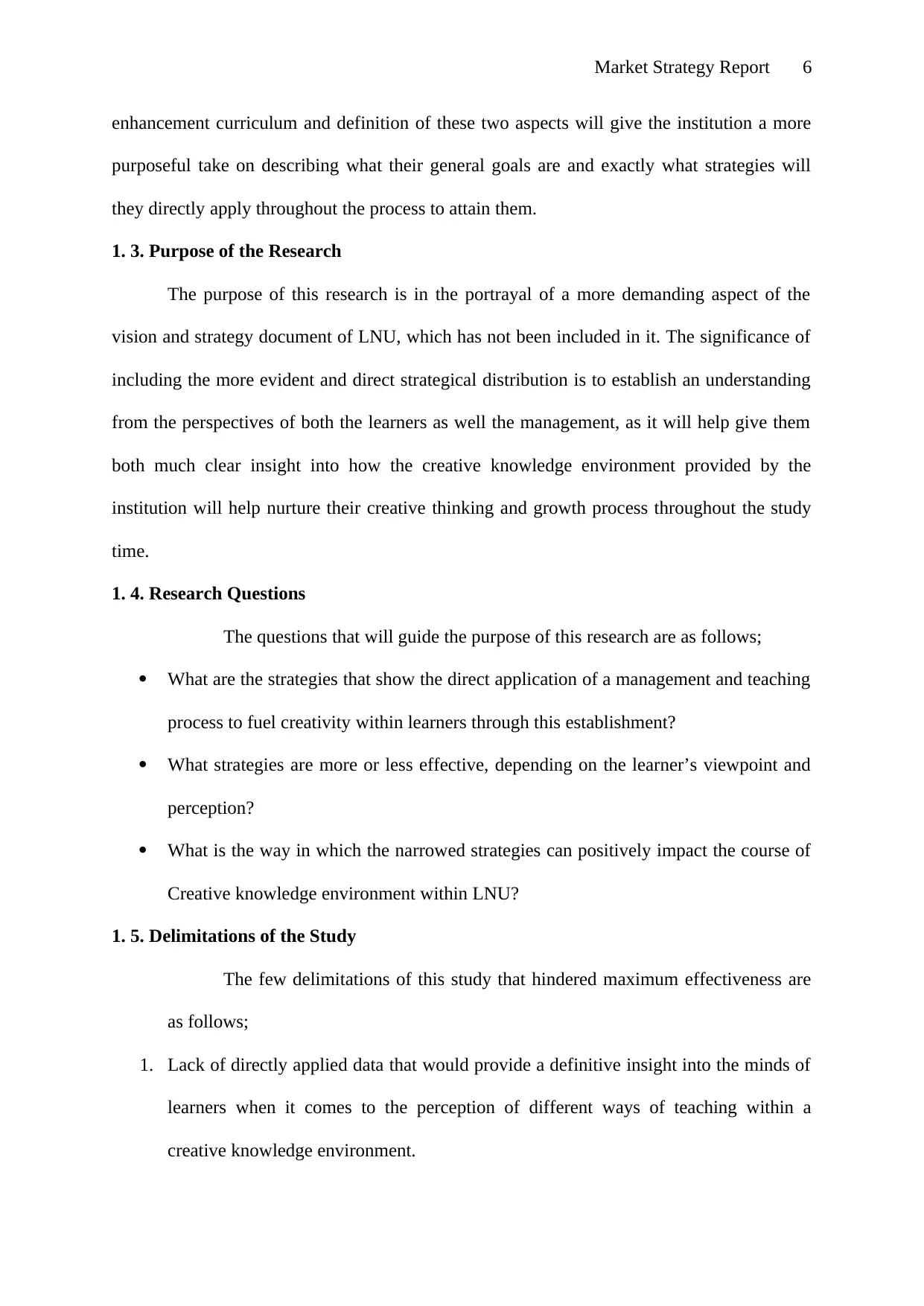
Market Strategy Report 6
enhancement curriculum and definition of these two aspects will give the institution a more
purposeful take on describing what their general goals are and exactly what strategies will
they directly apply throughout the process to attain them.
1. 3. Purpose of the Research
The purpose of this research is in the portrayal of a more demanding aspect of the
vision and strategy document of LNU, which has not been included in it. The significance of
including the more evident and direct strategical distribution is to establish an understanding
from the perspectives of both the learners as well the management, as it will help give them
both much clear insight into how the creative knowledge environment provided by the
institution will help nurture their creative thinking and growth process throughout the study
time.
1. 4. Research Questions
The questions that will guide the purpose of this research are as follows;
What are the strategies that show the direct application of a management and teaching
process to fuel creativity within learners through this establishment?
What strategies are more or less effective, depending on the learner’s viewpoint and
perception?
What is the way in which the narrowed strategies can positively impact the course of
Creative knowledge environment within LNU?
1. 5. Delimitations of the Study
The few delimitations of this study that hindered maximum effectiveness are
as follows;
1. Lack of directly applied data that would provide a definitive insight into the minds of
learners when it comes to the perception of different ways of teaching within a
creative knowledge environment.
enhancement curriculum and definition of these two aspects will give the institution a more
purposeful take on describing what their general goals are and exactly what strategies will
they directly apply throughout the process to attain them.
1. 3. Purpose of the Research
The purpose of this research is in the portrayal of a more demanding aspect of the
vision and strategy document of LNU, which has not been included in it. The significance of
including the more evident and direct strategical distribution is to establish an understanding
from the perspectives of both the learners as well the management, as it will help give them
both much clear insight into how the creative knowledge environment provided by the
institution will help nurture their creative thinking and growth process throughout the study
time.
1. 4. Research Questions
The questions that will guide the purpose of this research are as follows;
What are the strategies that show the direct application of a management and teaching
process to fuel creativity within learners through this establishment?
What strategies are more or less effective, depending on the learner’s viewpoint and
perception?
What is the way in which the narrowed strategies can positively impact the course of
Creative knowledge environment within LNU?
1. 5. Delimitations of the Study
The few delimitations of this study that hindered maximum effectiveness are
as follows;
1. Lack of directly applied data that would provide a definitive insight into the minds of
learners when it comes to the perception of different ways of teaching within a
creative knowledge environment.
⊘ This is a preview!⊘
Do you want full access?
Subscribe today to unlock all pages.

Trusted by 1+ million students worldwide
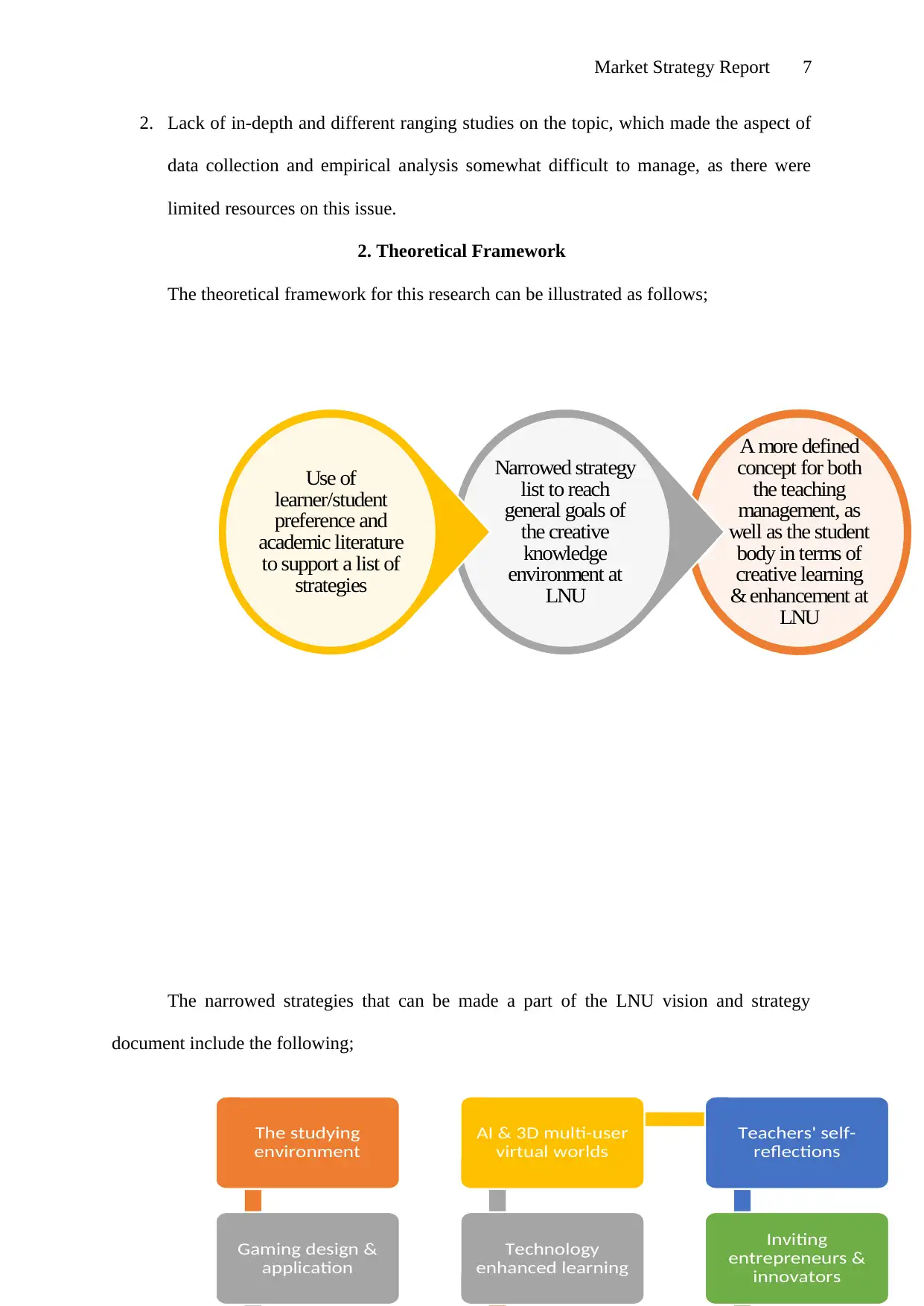
Market Strategy Report 7
2. Lack of in-depth and different ranging studies on the topic, which made the aspect of
data collection and empirical analysis somewhat difficult to manage, as there were
limited resources on this issue.
2. Theoretical Framework
The theoretical framework for this research can be illustrated as follows;
The narrowed strategies that can be made a part of the LNU vision and strategy
document include the following;
The studying
environment
Gaming design &
application
Technology
enhanced learning
AI & 3D multi-user
virtual worlds
Teachers' self-
reflections
Inviting
entrepreneurs &
innovators
A more defined
concept for both
the teaching
management, as
well as the student
body in terms of
creative learning
& enhancement at
LNU
Narrowed strategy
list to reach
general goals of
the creative
knowledge
environment at
LNU
Use of
learner/student
preference and
academic literature
to support a list of
strategies
2. Lack of in-depth and different ranging studies on the topic, which made the aspect of
data collection and empirical analysis somewhat difficult to manage, as there were
limited resources on this issue.
2. Theoretical Framework
The theoretical framework for this research can be illustrated as follows;
The narrowed strategies that can be made a part of the LNU vision and strategy
document include the following;
The studying
environment
Gaming design &
application
Technology
enhanced learning
AI & 3D multi-user
virtual worlds
Teachers' self-
reflections
Inviting
entrepreneurs &
innovators
A more defined
concept for both
the teaching
management, as
well as the student
body in terms of
creative learning
& enhancement at
LNU
Narrowed strategy
list to reach
general goals of
the creative
knowledge
environment at
LNU
Use of
learner/student
preference and
academic literature
to support a list of
strategies
Paraphrase This Document
Need a fresh take? Get an instant paraphrase of this document with our AI Paraphraser
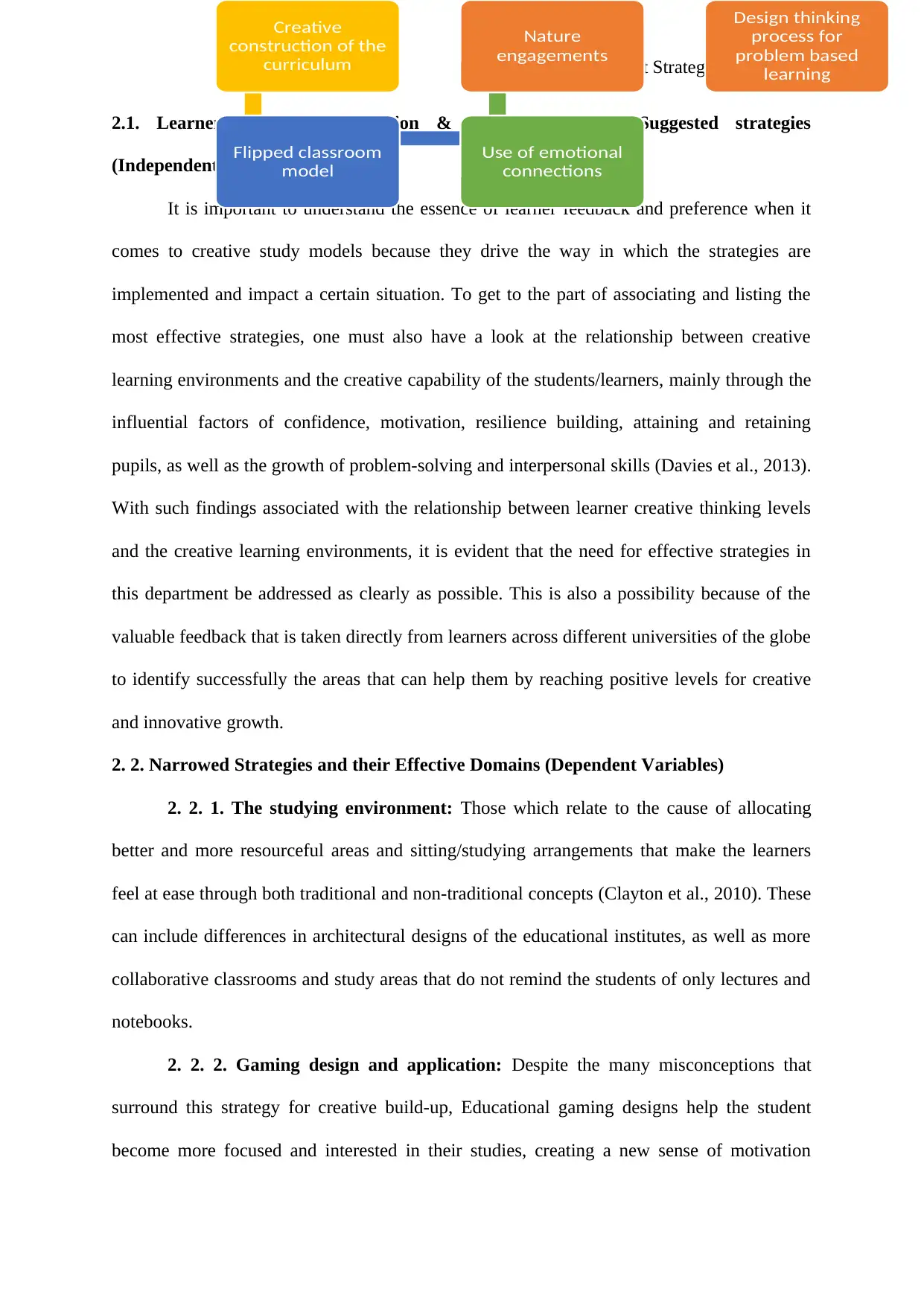
Market Strategy Report 8
2.1. Learners’/Students’ Evaluation & Reception of the Suggested strategies
(Independent Variable)
It is important to understand the essence of learner feedback and preference when it
comes to creative study models because they drive the way in which the strategies are
implemented and impact a certain situation. To get to the part of associating and listing the
most effective strategies, one must also have a look at the relationship between creative
learning environments and the creative capability of the students/learners, mainly through the
influential factors of confidence, motivation, resilience building, attaining and retaining
pupils, as well as the growth of problem-solving and interpersonal skills (Davies et al., 2013).
With such findings associated with the relationship between learner creative thinking levels
and the creative learning environments, it is evident that the need for effective strategies in
this department be addressed as clearly as possible. This is also a possibility because of the
valuable feedback that is taken directly from learners across different universities of the globe
to identify successfully the areas that can help them by reaching positive levels for creative
and innovative growth.
2. 2. Narrowed Strategies and their Effective Domains (Dependent Variables)
2. 2. 1. The studying environment: Those which relate to the cause of allocating
better and more resourceful areas and sitting/studying arrangements that make the learners
feel at ease through both traditional and non-traditional concepts (Clayton et al., 2010). These
can include differences in architectural designs of the educational institutes, as well as more
collaborative classrooms and study areas that do not remind the students of only lectures and
notebooks.
2. 2. 2. Gaming design and application: Despite the many misconceptions that
surround this strategy for creative build-up, Educational gaming designs help the student
become more focused and interested in their studies, creating a new sense of motivation
Creative
construction of the
curriculum
Flipped classroom
model
Use of emotional
connections
Nature
engagements
Design thinking
process for
problem based
learning
2.1. Learners’/Students’ Evaluation & Reception of the Suggested strategies
(Independent Variable)
It is important to understand the essence of learner feedback and preference when it
comes to creative study models because they drive the way in which the strategies are
implemented and impact a certain situation. To get to the part of associating and listing the
most effective strategies, one must also have a look at the relationship between creative
learning environments and the creative capability of the students/learners, mainly through the
influential factors of confidence, motivation, resilience building, attaining and retaining
pupils, as well as the growth of problem-solving and interpersonal skills (Davies et al., 2013).
With such findings associated with the relationship between learner creative thinking levels
and the creative learning environments, it is evident that the need for effective strategies in
this department be addressed as clearly as possible. This is also a possibility because of the
valuable feedback that is taken directly from learners across different universities of the globe
to identify successfully the areas that can help them by reaching positive levels for creative
and innovative growth.
2. 2. Narrowed Strategies and their Effective Domains (Dependent Variables)
2. 2. 1. The studying environment: Those which relate to the cause of allocating
better and more resourceful areas and sitting/studying arrangements that make the learners
feel at ease through both traditional and non-traditional concepts (Clayton et al., 2010). These
can include differences in architectural designs of the educational institutes, as well as more
collaborative classrooms and study areas that do not remind the students of only lectures and
notebooks.
2. 2. 2. Gaming design and application: Despite the many misconceptions that
surround this strategy for creative build-up, Educational gaming designs help the student
become more focused and interested in their studies, creating a new sense of motivation
Creative
construction of the
curriculum
Flipped classroom
model
Use of emotional
connections
Nature
engagements
Design thinking
process for
problem based
learning
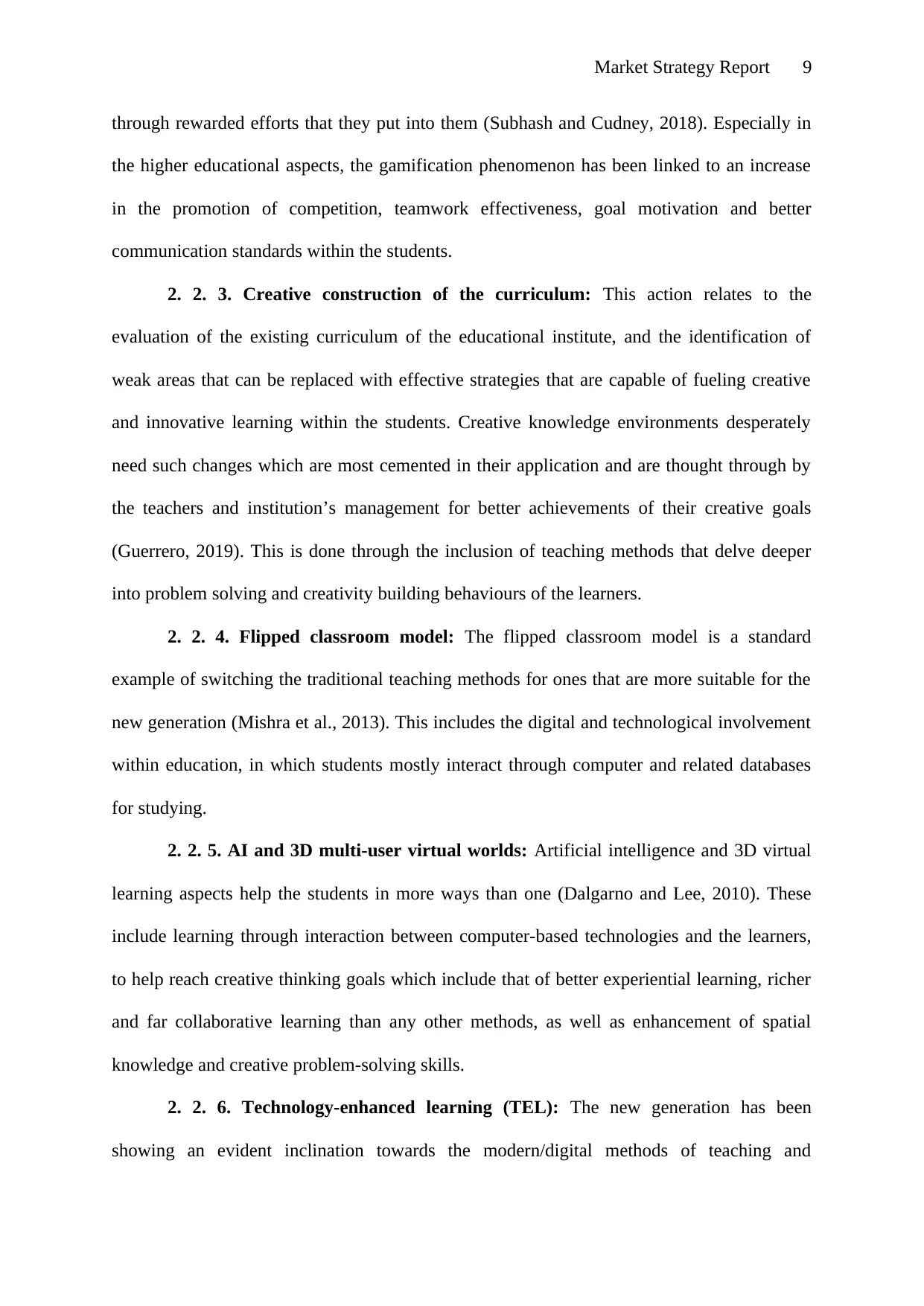
Market Strategy Report 9
through rewarded efforts that they put into them (Subhash and Cudney, 2018). Especially in
the higher educational aspects, the gamification phenomenon has been linked to an increase
in the promotion of competition, teamwork effectiveness, goal motivation and better
communication standards within the students.
2. 2. 3. Creative construction of the curriculum: This action relates to the
evaluation of the existing curriculum of the educational institute, and the identification of
weak areas that can be replaced with effective strategies that are capable of fueling creative
and innovative learning within the students. Creative knowledge environments desperately
need such changes which are most cemented in their application and are thought through by
the teachers and institution’s management for better achievements of their creative goals
(Guerrero, 2019). This is done through the inclusion of teaching methods that delve deeper
into problem solving and creativity building behaviours of the learners.
2. 2. 4. Flipped classroom model: The flipped classroom model is a standard
example of switching the traditional teaching methods for ones that are more suitable for the
new generation (Mishra et al., 2013). This includes the digital and technological involvement
within education, in which students mostly interact through computer and related databases
for studying.
2. 2. 5. AI and 3D multi-user virtual worlds: Artificial intelligence and 3D virtual
learning aspects help the students in more ways than one (Dalgarno and Lee, 2010). These
include learning through interaction between computer-based technologies and the learners,
to help reach creative thinking goals which include that of better experiential learning, richer
and far collaborative learning than any other methods, as well as enhancement of spatial
knowledge and creative problem-solving skills.
2. 2. 6. Technology-enhanced learning (TEL): The new generation has been
showing an evident inclination towards the modern/digital methods of teaching and
through rewarded efforts that they put into them (Subhash and Cudney, 2018). Especially in
the higher educational aspects, the gamification phenomenon has been linked to an increase
in the promotion of competition, teamwork effectiveness, goal motivation and better
communication standards within the students.
2. 2. 3. Creative construction of the curriculum: This action relates to the
evaluation of the existing curriculum of the educational institute, and the identification of
weak areas that can be replaced with effective strategies that are capable of fueling creative
and innovative learning within the students. Creative knowledge environments desperately
need such changes which are most cemented in their application and are thought through by
the teachers and institution’s management for better achievements of their creative goals
(Guerrero, 2019). This is done through the inclusion of teaching methods that delve deeper
into problem solving and creativity building behaviours of the learners.
2. 2. 4. Flipped classroom model: The flipped classroom model is a standard
example of switching the traditional teaching methods for ones that are more suitable for the
new generation (Mishra et al., 2013). This includes the digital and technological involvement
within education, in which students mostly interact through computer and related databases
for studying.
2. 2. 5. AI and 3D multi-user virtual worlds: Artificial intelligence and 3D virtual
learning aspects help the students in more ways than one (Dalgarno and Lee, 2010). These
include learning through interaction between computer-based technologies and the learners,
to help reach creative thinking goals which include that of better experiential learning, richer
and far collaborative learning than any other methods, as well as enhancement of spatial
knowledge and creative problem-solving skills.
2. 2. 6. Technology-enhanced learning (TEL): The new generation has been
showing an evident inclination towards the modern/digital methods of teaching and
⊘ This is a preview!⊘
Do you want full access?
Subscribe today to unlock all pages.

Trusted by 1+ million students worldwide
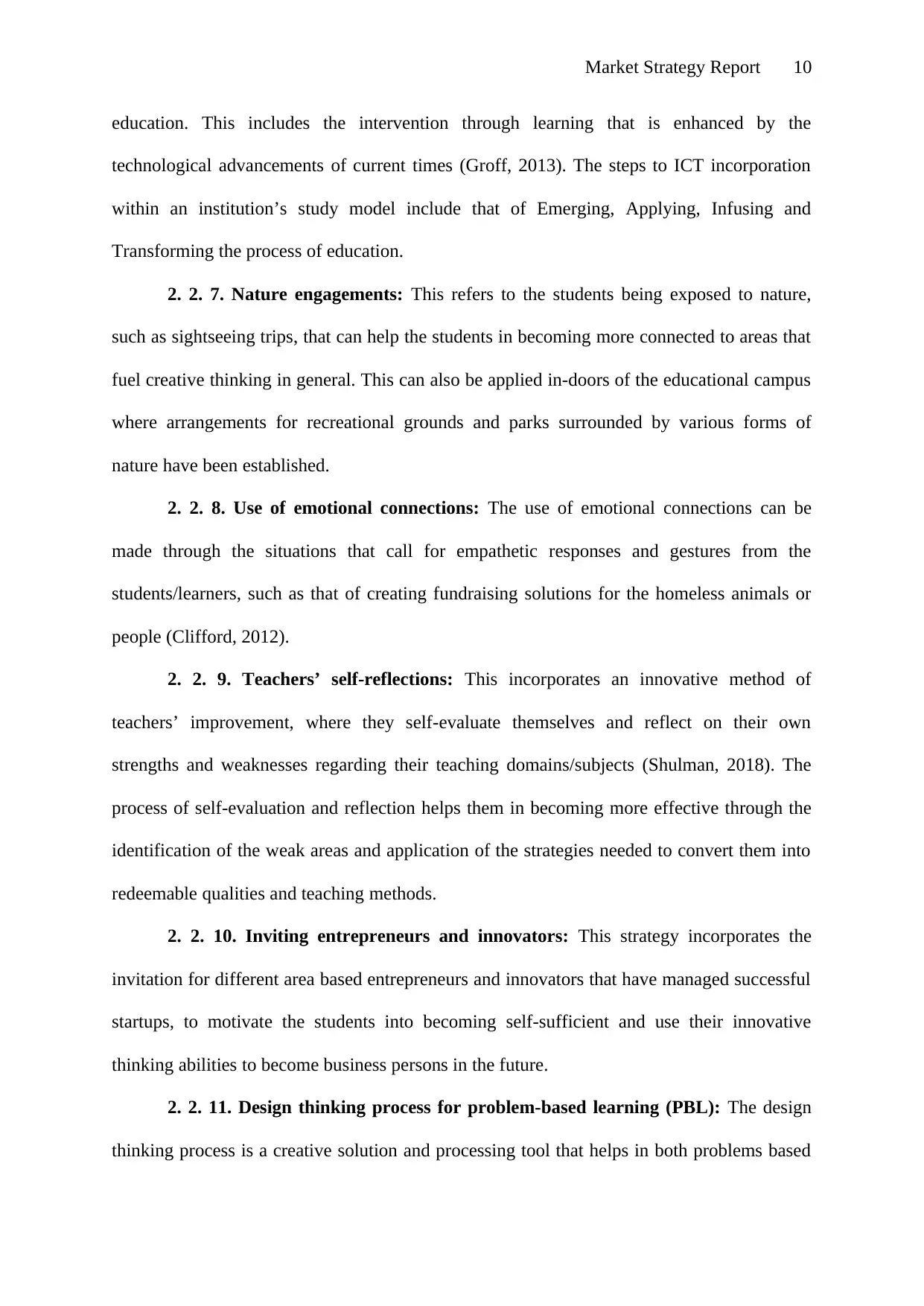
Market Strategy Report 10
education. This includes the intervention through learning that is enhanced by the
technological advancements of current times (Groff, 2013). The steps to ICT incorporation
within an institution’s study model include that of Emerging, Applying, Infusing and
Transforming the process of education.
2. 2. 7. Nature engagements: This refers to the students being exposed to nature,
such as sightseeing trips, that can help the students in becoming more connected to areas that
fuel creative thinking in general. This can also be applied in-doors of the educational campus
where arrangements for recreational grounds and parks surrounded by various forms of
nature have been established.
2. 2. 8. Use of emotional connections: The use of emotional connections can be
made through the situations that call for empathetic responses and gestures from the
students/learners, such as that of creating fundraising solutions for the homeless animals or
people (Clifford, 2012).
2. 2. 9. Teachers’ self-reflections: This incorporates an innovative method of
teachers’ improvement, where they self-evaluate themselves and reflect on their own
strengths and weaknesses regarding their teaching domains/subjects (Shulman, 2018). The
process of self-evaluation and reflection helps them in becoming more effective through the
identification of the weak areas and application of the strategies needed to convert them into
redeemable qualities and teaching methods.
2. 2. 10. Inviting entrepreneurs and innovators: This strategy incorporates the
invitation for different area based entrepreneurs and innovators that have managed successful
startups, to motivate the students into becoming self-sufficient and use their innovative
thinking abilities to become business persons in the future.
2. 2. 11. Design thinking process for problem-based learning (PBL): The design
thinking process is a creative solution and processing tool that helps in both problems based
education. This includes the intervention through learning that is enhanced by the
technological advancements of current times (Groff, 2013). The steps to ICT incorporation
within an institution’s study model include that of Emerging, Applying, Infusing and
Transforming the process of education.
2. 2. 7. Nature engagements: This refers to the students being exposed to nature,
such as sightseeing trips, that can help the students in becoming more connected to areas that
fuel creative thinking in general. This can also be applied in-doors of the educational campus
where arrangements for recreational grounds and parks surrounded by various forms of
nature have been established.
2. 2. 8. Use of emotional connections: The use of emotional connections can be
made through the situations that call for empathetic responses and gestures from the
students/learners, such as that of creating fundraising solutions for the homeless animals or
people (Clifford, 2012).
2. 2. 9. Teachers’ self-reflections: This incorporates an innovative method of
teachers’ improvement, where they self-evaluate themselves and reflect on their own
strengths and weaknesses regarding their teaching domains/subjects (Shulman, 2018). The
process of self-evaluation and reflection helps them in becoming more effective through the
identification of the weak areas and application of the strategies needed to convert them into
redeemable qualities and teaching methods.
2. 2. 10. Inviting entrepreneurs and innovators: This strategy incorporates the
invitation for different area based entrepreneurs and innovators that have managed successful
startups, to motivate the students into becoming self-sufficient and use their innovative
thinking abilities to become business persons in the future.
2. 2. 11. Design thinking process for problem-based learning (PBL): The design
thinking process is a creative solution and processing tool that helps in both problems based
Paraphrase This Document
Need a fresh take? Get an instant paraphrase of this document with our AI Paraphraser
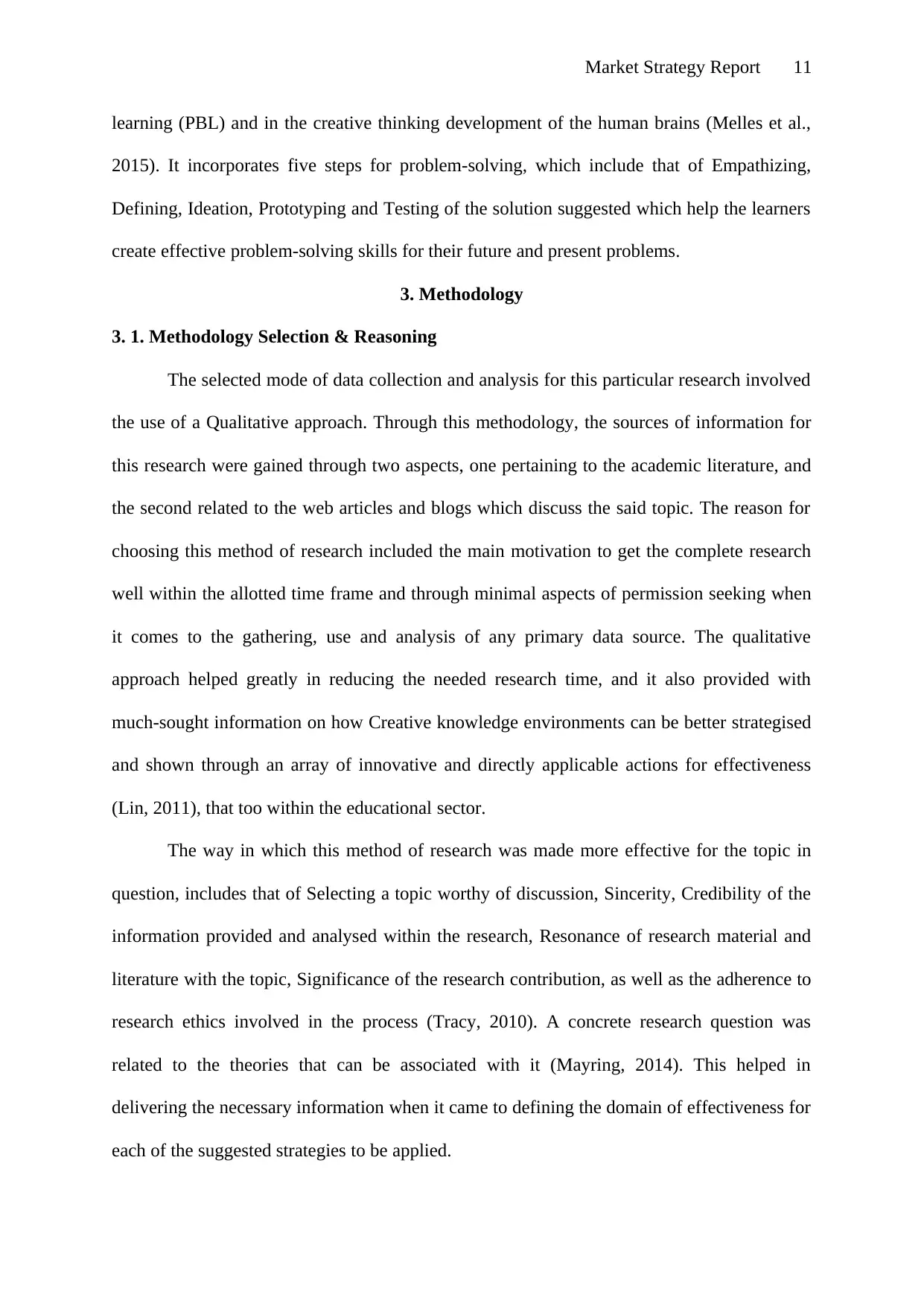
Market Strategy Report 11
learning (PBL) and in the creative thinking development of the human brains (Melles et al.,
2015). It incorporates five steps for problem-solving, which include that of Empathizing,
Defining, Ideation, Prototyping and Testing of the solution suggested which help the learners
create effective problem-solving skills for their future and present problems.
3. Methodology
3. 1. Methodology Selection & Reasoning
The selected mode of data collection and analysis for this particular research involved
the use of a Qualitative approach. Through this methodology, the sources of information for
this research were gained through two aspects, one pertaining to the academic literature, and
the second related to the web articles and blogs which discuss the said topic. The reason for
choosing this method of research included the main motivation to get the complete research
well within the allotted time frame and through minimal aspects of permission seeking when
it comes to the gathering, use and analysis of any primary data source. The qualitative
approach helped greatly in reducing the needed research time, and it also provided with
much-sought information on how Creative knowledge environments can be better strategised
and shown through an array of innovative and directly applicable actions for effectiveness
(Lin, 2011), that too within the educational sector.
The way in which this method of research was made more effective for the topic in
question, includes that of Selecting a topic worthy of discussion, Sincerity, Credibility of the
information provided and analysed within the research, Resonance of research material and
literature with the topic, Significance of the research contribution, as well as the adherence to
research ethics involved in the process (Tracy, 2010). A concrete research question was
related to the theories that can be associated with it (Mayring, 2014). This helped in
delivering the necessary information when it came to defining the domain of effectiveness for
each of the suggested strategies to be applied.
learning (PBL) and in the creative thinking development of the human brains (Melles et al.,
2015). It incorporates five steps for problem-solving, which include that of Empathizing,
Defining, Ideation, Prototyping and Testing of the solution suggested which help the learners
create effective problem-solving skills for their future and present problems.
3. Methodology
3. 1. Methodology Selection & Reasoning
The selected mode of data collection and analysis for this particular research involved
the use of a Qualitative approach. Through this methodology, the sources of information for
this research were gained through two aspects, one pertaining to the academic literature, and
the second related to the web articles and blogs which discuss the said topic. The reason for
choosing this method of research included the main motivation to get the complete research
well within the allotted time frame and through minimal aspects of permission seeking when
it comes to the gathering, use and analysis of any primary data source. The qualitative
approach helped greatly in reducing the needed research time, and it also provided with
much-sought information on how Creative knowledge environments can be better strategised
and shown through an array of innovative and directly applicable actions for effectiveness
(Lin, 2011), that too within the educational sector.
The way in which this method of research was made more effective for the topic in
question, includes that of Selecting a topic worthy of discussion, Sincerity, Credibility of the
information provided and analysed within the research, Resonance of research material and
literature with the topic, Significance of the research contribution, as well as the adherence to
research ethics involved in the process (Tracy, 2010). A concrete research question was
related to the theories that can be associated with it (Mayring, 2014). This helped in
delivering the necessary information when it came to defining the domain of effectiveness for
each of the suggested strategies to be applied.
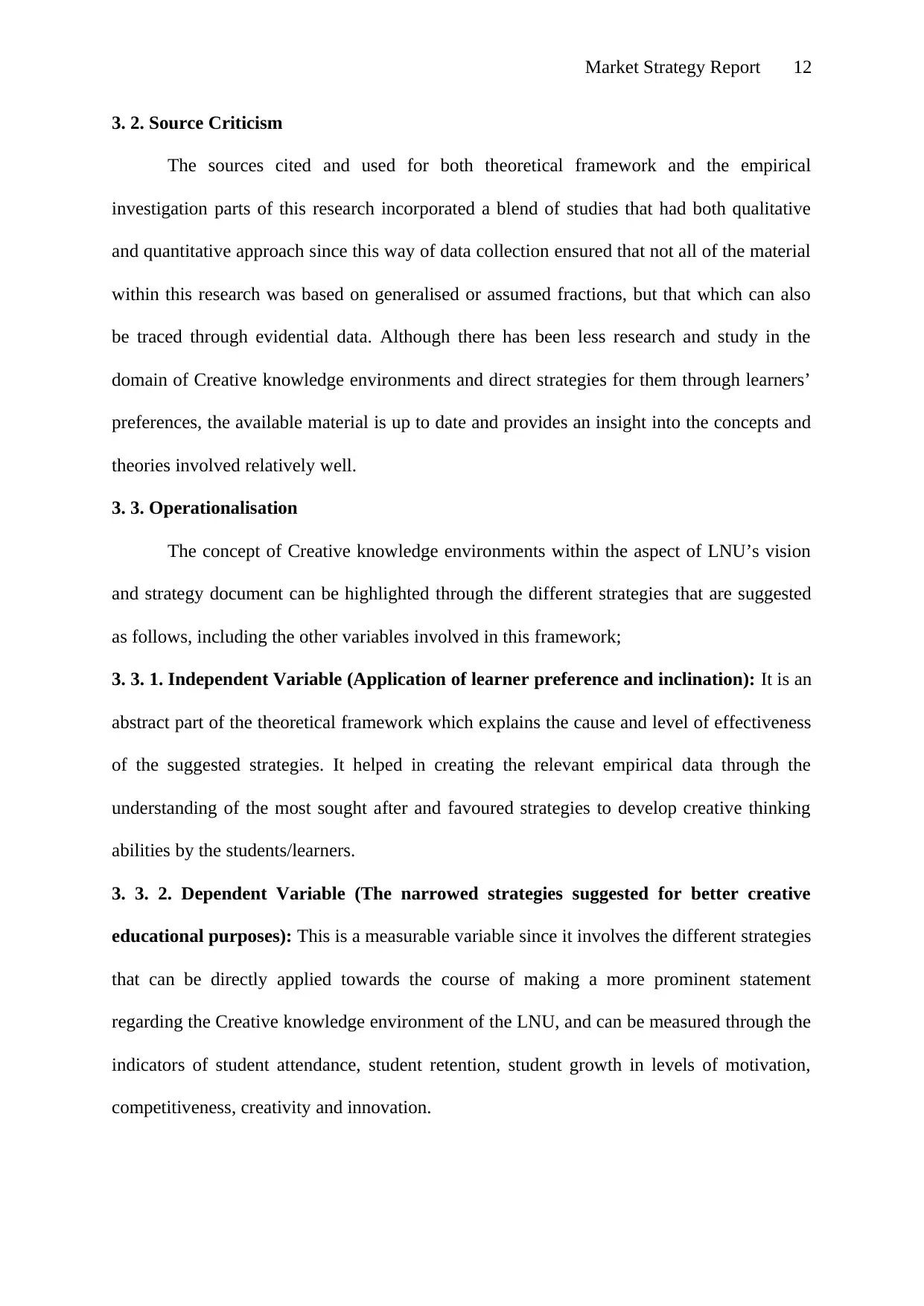
Market Strategy Report 12
3. 2. Source Criticism
The sources cited and used for both theoretical framework and the empirical
investigation parts of this research incorporated a blend of studies that had both qualitative
and quantitative approach since this way of data collection ensured that not all of the material
within this research was based on generalised or assumed fractions, but that which can also
be traced through evidential data. Although there has been less research and study in the
domain of Creative knowledge environments and direct strategies for them through learners’
preferences, the available material is up to date and provides an insight into the concepts and
theories involved relatively well.
3. 3. Operationalisation
The concept of Creative knowledge environments within the aspect of LNU’s vision
and strategy document can be highlighted through the different strategies that are suggested
as follows, including the other variables involved in this framework;
3. 3. 1. Independent Variable (Application of learner preference and inclination): It is an
abstract part of the theoretical framework which explains the cause and level of effectiveness
of the suggested strategies. It helped in creating the relevant empirical data through the
understanding of the most sought after and favoured strategies to develop creative thinking
abilities by the students/learners.
3. 3. 2. Dependent Variable (The narrowed strategies suggested for better creative
educational purposes): This is a measurable variable since it involves the different strategies
that can be directly applied towards the course of making a more prominent statement
regarding the Creative knowledge environment of the LNU, and can be measured through the
indicators of student attendance, student retention, student growth in levels of motivation,
competitiveness, creativity and innovation.
3. 2. Source Criticism
The sources cited and used for both theoretical framework and the empirical
investigation parts of this research incorporated a blend of studies that had both qualitative
and quantitative approach since this way of data collection ensured that not all of the material
within this research was based on generalised or assumed fractions, but that which can also
be traced through evidential data. Although there has been less research and study in the
domain of Creative knowledge environments and direct strategies for them through learners’
preferences, the available material is up to date and provides an insight into the concepts and
theories involved relatively well.
3. 3. Operationalisation
The concept of Creative knowledge environments within the aspect of LNU’s vision
and strategy document can be highlighted through the different strategies that are suggested
as follows, including the other variables involved in this framework;
3. 3. 1. Independent Variable (Application of learner preference and inclination): It is an
abstract part of the theoretical framework which explains the cause and level of effectiveness
of the suggested strategies. It helped in creating the relevant empirical data through the
understanding of the most sought after and favoured strategies to develop creative thinking
abilities by the students/learners.
3. 3. 2. Dependent Variable (The narrowed strategies suggested for better creative
educational purposes): This is a measurable variable since it involves the different strategies
that can be directly applied towards the course of making a more prominent statement
regarding the Creative knowledge environment of the LNU, and can be measured through the
indicators of student attendance, student retention, student growth in levels of motivation,
competitiveness, creativity and innovation.
⊘ This is a preview!⊘
Do you want full access?
Subscribe today to unlock all pages.

Trusted by 1+ million students worldwide
1 out of 24
Related Documents
Your All-in-One AI-Powered Toolkit for Academic Success.
+13062052269
info@desklib.com
Available 24*7 on WhatsApp / Email
![[object Object]](/_next/static/media/star-bottom.7253800d.svg)
Unlock your academic potential
Copyright © 2020–2025 A2Z Services. All Rights Reserved. Developed and managed by ZUCOL.




